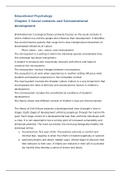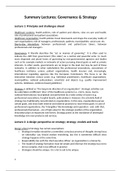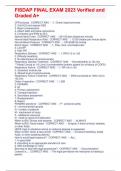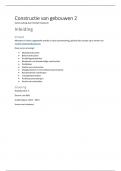Operations & Supply Chain Management Notes
Only Book
Fleur Bongers
,Table of Contents
Chapter 1 ......................................................................................................................... 3
Chapter 2 ....................................................................................................................... 13
Chapter 9 ....................................................................................................................... 25
Chapter 3 ....................................................................................................................... 35
Chapter 5 ....................................................................................................................... 43
Chapter 15...................................................................................................................... 52
Chapter 7 ....................................................................................................................... 63
Session 10 ...................................................................................................................... 73
2
,Chapter 1
Summary
Does the organisation understand the potential of operations and process management?
The operations function is the part of the organisation that produces products or services.
Every organisation has an operations function because every organisation produces some
mixture of products and services. It is a central and important activity for any organisation.
‘Operations’ is not always called by that name, but whatever its name, it is always concerned
with managing the core purpose of the business – producing some mix of products and
services. Processes also produce products and services, but on a smaller scale. They are the
component parts of operations. But other functions also have processes that need
managing. In fact, every part of any business is concerned with managing processes. All
managers have something to learn from studying operations and process management,
because the subject encompasses the management of all types of operation, no matter in
what sector or industry, and all processes, no matter in which function.
Does the business take a process perspective?
A ‘process perspective’ means understanding businesses in terms of all their individual
processes. It is only one way of modelling organisations, but it is a particularly use- ful one.
Operations and process management uses the process perspective to analyse businesses at
three levels: the operations function of the business; the higher and strategic level of the
supply network; and at a lower operational level of individual processes. Within the
business, processes are only what they are defined as being. The boundaries of each process
can be drawn as thought appropriate. Sometimes this involves radically reshaping the way
processes are organised; for example, to form end-to-end processes that fulfil customer
needs.
Does operations and process management have a strategic impact?
Operations and process management can make or break a business. Well-managed
operations and processes can contribute to the strategic impact of the business in four ways:
cost, revenue, investment and capabilities. Because the operations function has
responsibility for much of a business’s cost base, its first imperative is to keep costs under
control. Additionally, it should look to enhance the business’s ability to gener- ate revenue
through the way it provides service and quality. Furthermore, all failures are ultimately
process failures; well-designed processes have less chance of failing
and more chance of recovering quickly from failure. Because operations are often the source
of much investment, it should aim to get the best possible return on that investment. Finally,
the operations function should lay down the capabilities that will form the long-term basis
for future competitiveness.
Should all processes be managed in the same way?
Not necessarily. Processes differ, particularly in what are known as the four Vs: vol- ume,
variety, variation and visibility. High-volume processes can exploit economies
of scale and be systematised. High-variety processes require enough inbuilt flexibility to
cope with the wide variety of activities expected of them. High-variation processes must be
able to change their output levels to cope with highly variable and/or unpre- dictable levels
of demand. High-visibility processes add value, while the customer is ‘present’ in some way
and therefore must be able to manage customers’ perceptions of their activities. Generally,
3
, high volume together with low variety, variation and vis- ibility facilitate low-cost processes,
while low volume together with high levels of vari- ety, variation and visibility all increase
process costs. Yet in spite of these differences, operations managers use a common set of
decisions and activities to manage them. These activities can be clustered under four
groupings: directing the overall strategy of the operation; designing the operation’s
products, services and processes; planning and controlling process delivery; and developing
process performance.
Are operations and process decision-making appropriate?
The range of operations decisions are wide-ranging and cover four broad areas that we
categorise as follows: ‘directing the overall strategy of the operation’; ‘designing the
operation’s processes’; ‘planning and control process delivery’; and ‘develop-
ing process performance’. However, there are always overlaps and interrelationships
between the categories. Yet, no matter what type of decision, operations managers use
models (many of which are included in this book) to help them make decisions. Some
models are quantitative, some are qualitative but, in practice, a blend of qualita- tive and
quantitative approaches is often the most useful approach. Remember that all models are
simplifications of a far more complex reality. This is one reason for the interest in
‘behavioural operations management’, which attempts to incorporate real (usually non-
rational) behaviour into operations decision-making.
Strategic Impact of Operations:
• Contribution to Business Strategy: Well-managed operations impact strategically in
terms of cost, revenue, investment, and capabilities.
• Imperatives: Controlling costs, enhancing revenue generation, minimizing failures,
optimizing investments, and laying down long-term capabilities.
Managing Different Processes:
• Four Vs: Volume, variety, variation, and visibility distinguish processes.
• Decision Clusters: Operations managers make decisions related to directing strategy,
designing processes, planning and controlling delivery, and developing performance.
Operations Decision-Making:
• Broad Areas: Decisions categorized into directing strategy, designing processes,
planning and control, and developing performance.
• Overlaps: Decision categories have overlaps and interrelationships.
• Model Utilization: Operations managers use models, both quantitative and
qualitative.
Operations Principles:
• Core Concept: All organizations have operations producing a mix of products and
services.
4
Only Book
Fleur Bongers
,Table of Contents
Chapter 1 ......................................................................................................................... 3
Chapter 2 ....................................................................................................................... 13
Chapter 9 ....................................................................................................................... 25
Chapter 3 ....................................................................................................................... 35
Chapter 5 ....................................................................................................................... 43
Chapter 15...................................................................................................................... 52
Chapter 7 ....................................................................................................................... 63
Session 10 ...................................................................................................................... 73
2
,Chapter 1
Summary
Does the organisation understand the potential of operations and process management?
The operations function is the part of the organisation that produces products or services.
Every organisation has an operations function because every organisation produces some
mixture of products and services. It is a central and important activity for any organisation.
‘Operations’ is not always called by that name, but whatever its name, it is always concerned
with managing the core purpose of the business – producing some mix of products and
services. Processes also produce products and services, but on a smaller scale. They are the
component parts of operations. But other functions also have processes that need
managing. In fact, every part of any business is concerned with managing processes. All
managers have something to learn from studying operations and process management,
because the subject encompasses the management of all types of operation, no matter in
what sector or industry, and all processes, no matter in which function.
Does the business take a process perspective?
A ‘process perspective’ means understanding businesses in terms of all their individual
processes. It is only one way of modelling organisations, but it is a particularly use- ful one.
Operations and process management uses the process perspective to analyse businesses at
three levels: the operations function of the business; the higher and strategic level of the
supply network; and at a lower operational level of individual processes. Within the
business, processes are only what they are defined as being. The boundaries of each process
can be drawn as thought appropriate. Sometimes this involves radically reshaping the way
processes are organised; for example, to form end-to-end processes that fulfil customer
needs.
Does operations and process management have a strategic impact?
Operations and process management can make or break a business. Well-managed
operations and processes can contribute to the strategic impact of the business in four ways:
cost, revenue, investment and capabilities. Because the operations function has
responsibility for much of a business’s cost base, its first imperative is to keep costs under
control. Additionally, it should look to enhance the business’s ability to gener- ate revenue
through the way it provides service and quality. Furthermore, all failures are ultimately
process failures; well-designed processes have less chance of failing
and more chance of recovering quickly from failure. Because operations are often the source
of much investment, it should aim to get the best possible return on that investment. Finally,
the operations function should lay down the capabilities that will form the long-term basis
for future competitiveness.
Should all processes be managed in the same way?
Not necessarily. Processes differ, particularly in what are known as the four Vs: vol- ume,
variety, variation and visibility. High-volume processes can exploit economies
of scale and be systematised. High-variety processes require enough inbuilt flexibility to
cope with the wide variety of activities expected of them. High-variation processes must be
able to change their output levels to cope with highly variable and/or unpre- dictable levels
of demand. High-visibility processes add value, while the customer is ‘present’ in some way
and therefore must be able to manage customers’ perceptions of their activities. Generally,
3
, high volume together with low variety, variation and vis- ibility facilitate low-cost processes,
while low volume together with high levels of vari- ety, variation and visibility all increase
process costs. Yet in spite of these differences, operations managers use a common set of
decisions and activities to manage them. These activities can be clustered under four
groupings: directing the overall strategy of the operation; designing the operation’s
products, services and processes; planning and controlling process delivery; and developing
process performance.
Are operations and process decision-making appropriate?
The range of operations decisions are wide-ranging and cover four broad areas that we
categorise as follows: ‘directing the overall strategy of the operation’; ‘designing the
operation’s processes’; ‘planning and control process delivery’; and ‘develop-
ing process performance’. However, there are always overlaps and interrelationships
between the categories. Yet, no matter what type of decision, operations managers use
models (many of which are included in this book) to help them make decisions. Some
models are quantitative, some are qualitative but, in practice, a blend of qualita- tive and
quantitative approaches is often the most useful approach. Remember that all models are
simplifications of a far more complex reality. This is one reason for the interest in
‘behavioural operations management’, which attempts to incorporate real (usually non-
rational) behaviour into operations decision-making.
Strategic Impact of Operations:
• Contribution to Business Strategy: Well-managed operations impact strategically in
terms of cost, revenue, investment, and capabilities.
• Imperatives: Controlling costs, enhancing revenue generation, minimizing failures,
optimizing investments, and laying down long-term capabilities.
Managing Different Processes:
• Four Vs: Volume, variety, variation, and visibility distinguish processes.
• Decision Clusters: Operations managers make decisions related to directing strategy,
designing processes, planning and controlling delivery, and developing performance.
Operations Decision-Making:
• Broad Areas: Decisions categorized into directing strategy, designing processes,
planning and control, and developing performance.
• Overlaps: Decision categories have overlaps and interrelationships.
• Model Utilization: Operations managers use models, both quantitative and
qualitative.
Operations Principles:
• Core Concept: All organizations have operations producing a mix of products and
services.
4











